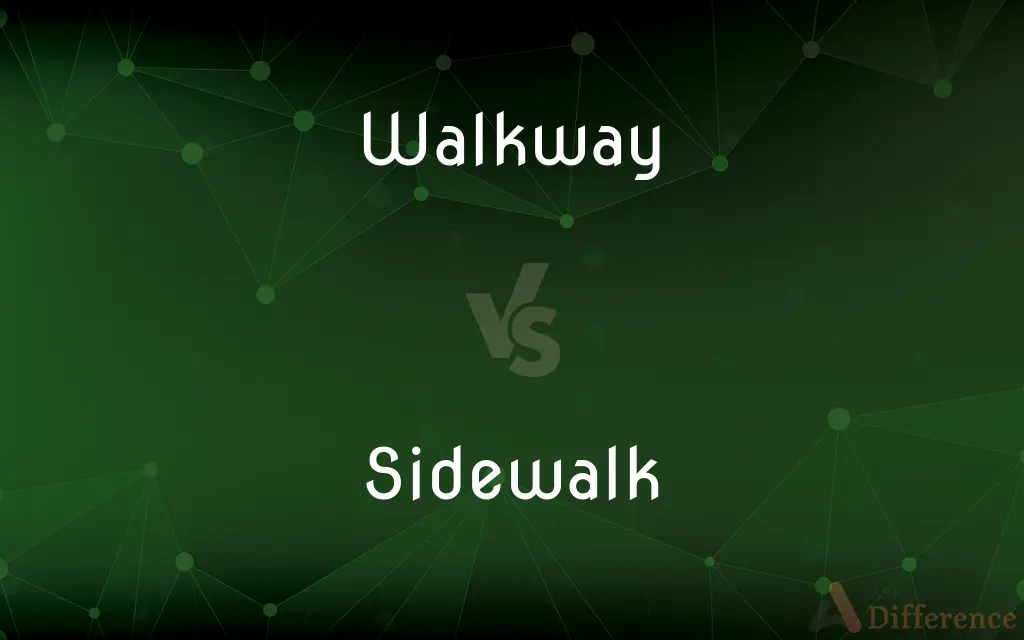Walkway vs. Sidewalk — What's the Difference?
By Fiza Rafique & Urooj Arif — Updated on March 13, 2024
A walkway is a path designed for pedestrian use, often within parks or gardens, while a sidewalk is a paved path alongside a street for pedestrian use.

Difference Between Walkway and Sidewalk
Table of Contents
ADVERTISEMENT
Key Differences
Walkways are paths designated for walking, which can be found in a variety of environments such as parks, gardens, around buildings, or connecting different sections of a property. Sidewalks, on the other hand, are specifically constructed alongside streets and roads, providing a safe space for pedestrians to walk parallel to vehicular traffic.
Walkways might serve aesthetic purposes or recreational activities, like strolling through a park, whereas sidewalks are more utilitarian, focusing on providing a safe and efficient route for pedestrians in urban environments.
The design of walkways can vary greatly, reflecting the landscape and intended use. They might meander through a scenic area, include benches and lighting for comfort and safety, and integrate with the surrounding landscape. Sidewalks, while functional, may also incorporate urban design elements such as trees, lighting, and crossings but always with a focus on practicality and safety.
Both walkways and sidewalks play crucial roles in promoting walkability and accessibility in their respective settings. However, the key differences lie in their location, purpose, and design, reflecting the specific needs of pedestrians in varied environments.
Comparison Chart
Location
Parks, gardens, around buildings
Alongside streets and roads
ADVERTISEMENT
Material
Gravel, stone, wood, concrete
Concrete, asphalt
Purpose
Facilitate pedestrian movement, recreation
Ensure pedestrian safety, urban connectivity
Setting
Urban and natural settings
Urban and suburban areas
Design Variety
Can vary greatly, often scenic
More uniform, focused on safety and function
Compare with Definitions
Walkway
A path designated for pedestrian use, often scenic.
The garden's walkway is lined with beautiful flowers.
Sidewalk
A paved path alongside streets for pedestrian use.
The city added a new sidewalk to improve pedestrian safety.
Walkway
Focuses on aesthetic and recreational use.
The winding walkway offers stunning views of the lake.
Sidewalk
Typically made of concrete or asphalt.
The new asphalt sidewalk replaced the old, cracked pavement.
Walkway
Found in parks, gardens, and around buildings.
The stone walkway around the building provides a pleasant route for a walk.
Sidewalk
May include urban design elements for safety.
The sidewalk was widened and now includes pedestrian crossing signs.
Walkway
Integrates with landscape design.
The landscaped walkway seamlessly blends with the surrounding gardens.
Sidewalk
Provides a safe space away from vehicular traffic.
Parents teach their children to stay on the sidewalk for safety.
Walkway
Can be made from a variety of materials.
The wooden walkway leads visitors through the wetlands.
Sidewalk
Essential for urban and suburban connectivity.
The sidewalk network allows residents to walk to nearby shops safely.
Walkway
In American English, walkway is a composite or umbrella term for all engineered surfaces or structures which support the use of trails. The New Oxford American Dictionary also defines a walkway as "a passage or path for walking along, esp.
Sidewalk
A sidewalk (North American English), pavement (British English), footpath (Oceanian English), or footway, is a path along the side of a road. Usually constructed of concrete or asphalt, it is designed for pedestrians.
Walkway
A passage or path for walking along, especially a raised passageway connecting different sections of a building or a wide path in a park or garden.
Sidewalk
A paved walkway along the side of a street.
Walkway
A passage or path for walking, especially one that is roofed, paved, or elevated above its surroundings.
Sidewalk
(US) (usually) a paved footpath located at the side of a road, for the use of pedestrians
Walkway
A clearly defined path for pedestrians.
Sidewalk
Any paved footpath, even if not located at the side of a road
Walkway
A path set aside for walking;
After the blizzard he shoveled the front walk
Sidewalk
A walk for foot passengers at the side of a street or road; a foot pavement.
Sidewalk
Walk consisting of a paved area for pedestrians; usually beside a street or roadway
Common Curiosities
How does a sidewalk differ from a walkway?
A sidewalk is a specific type of walkway constructed alongside streets and roads to ensure pedestrian safety by separating them from vehicular traffic, typically made of concrete or asphalt.
Can walkways and sidewalks serve the same purpose?
While both serve pedestrians, walkways offer more recreational and aesthetic purposes, whereas sidewalks focus on safety and urban connectivity.
Are sidewalks only found in urban areas?
Sidewalks are primarily found in urban and suburban areas to facilitate safe pedestrian movement alongside roads.
Can both walkways and sidewalks be accessible to individuals with disabilities?
Yes, both walkways and sidewalks can and should be designed to be accessible, following guidelines to ensure they are usable by individuals with disabilities.
Do walkways contribute to the aesthetic value of a place?
Yes, walkways often contribute significantly to the aesthetic and recreational value of a place, integrating with the landscape and providing scenic routes.
What is a walkway?
A walkway is a path designed for pedestrian use, often found in parks, gardens, and around buildings, that can be made from various materials.
What materials are used for walkways?
Walkways can be constructed from a variety of materials including gravel, stone, wood, and concrete, depending on their location and design purpose.
Why are sidewalks important in cities?
Sidewalks are crucial for pedestrian safety, allowing people to walk safely alongside but separated from vehicular traffic, and connect different urban areas.
Can a path in a rural area be considered a sidewalk?
A path in a rural area, if designed primarily for pedestrian use alongside a road, could be considered a sidewalk, though it might not have the typical urban construction.
How do urban planners decide where to place sidewalks?
Urban planners consider factors like pedestrian traffic, road safety, connectivity, and accessibility when deciding where to place sidewalks.
Share Your Discovery

Previous Comparison
Kerosene vs. Petrol
Next Comparison
Switch vs. TurnAuthor Spotlight
Written by
Fiza RafiqueFiza Rafique is a skilled content writer at AskDifference.com, where she meticulously refines and enhances written pieces. Drawing from her vast editorial expertise, Fiza ensures clarity, accuracy, and precision in every article. Passionate about language, she continually seeks to elevate the quality of content for readers worldwide.
Co-written by
Urooj ArifUrooj is a skilled content writer at Ask Difference, known for her exceptional ability to simplify complex topics into engaging and informative content. With a passion for research and a flair for clear, concise writing, she consistently delivers articles that resonate with our diverse audience.














































